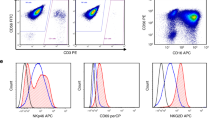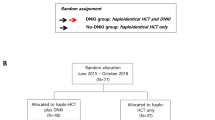Abstract
Natural killer (NK) cells have an important function in the anti-tumor response early after stem cell transplantation (SCT). As part of a prospective randomized phase III study, directly comparing the use of CD3+/CD19+-depleted peripheral blood stem cell (PBSC) harvests with CD34+-selected PBSC harvests in allogeneic human leukocyte antigen-matched SCT, we here show that the use of CD3+/CD19+-depleted PBSC grafts leads to early NK cell repopulation and reconstitution of the CD56dim and CD56bright NK cell subsets, with concomitant high cytolytic capacity. In the CD34 group, this process took significantly longer. Moreover, in the CD3/19 group after reconstitution, a higher percentage of killer immunoglobulin-like receptor-positive NK cells was found. Although similar percentages of CD94-positive NK cells were found in both groups, in the CD34 group, almost all expressed the inhibitory CD94:NKG2A complex, whereas in the CD3/19 group, the inhibitory CD94:NKG2A and the activating CD94:NKG2C complex were equally distributed. This preferential development of NKG2C-expressing NK cells in the CD3/19 group was paralleled by a loss of NKG2A-mediated inhibition of NK cell degranulation. These results show that the use of CD3+/CD19+-depleted grafts facilitates strong NK cell cytolytic responses directly after SCT, and the rapid emergence of an NK cell receptor phenotype that is more prone to activation.
This is a preview of subscription content, access via your institution
Access options
Subscribe to this journal
Receive 12 print issues and online access
$259.00 per year
only $21.58 per issue
Buy this article
- Purchase on Springer Link
- Instant access to full article PDF
Prices may be subject to local taxes which are calculated during checkout







Similar content being viewed by others
References
Farag SS, Caligiuri MA . Human natural killer cell development and biology. Blood Rev 2006; 20: 123–137.
Papamichail M, Perez SA, Gritzapis AD, Baxevanis CN . Natural killer lymphocytes: biology, development, and function. Cancer Immunol Immunother 2004; 53: 176–186.
Parham P . MHC class I molecules and KIRs in human history, health and survival. Nat Rev Immunol 2005; 5: 201–214.
Braud VM, Allan DS, O’Callaghan CA, Soderstrom K, D’Andrea A, Ogg GS et al. HLA-E binds to natural killer cell receptors CD94/NKG2A, B and C. Nature 1998; 391: 795–799.
Moretta A, Bottino C, Vitale M, Pende D, Cantoni C, Mingari MC et al. Activating receptors and coreceptors involved in human natural killer cell-mediated cytolysis. Annu Rev Immunol 2001; 19: 197–223.
Cook MA, Milligan DW, Fegan CD, Darbyshire PJ, Mahendra P, Craddock CF et al. The impact of donor KIR and patient HLA-C genotypes on outcome following HLA-identical sibling hematopoietic stem cell transplantation for myeloid leukemia. Blood 2004; 103: 1521–1526.
Giebel S, Nowak I, Wojnar J, Markiewicz M, Dziaczkowska J, Wylezol I et al. Impact of activating killer immunoglobulin-like receptor genotype on outcome of unrelated donor-hematopoietic cell transplantation. Transplant Proc 2006; 38: 287–291.
Ruggeri L, Capanni M, Urbani E, Perruccio K, Shlomchik WD, Tosti A et al. Effectiveness of donor natural killer cell alloreactivity in mismatched hematopoietic transplants. Science 2002; 295: 2097–2100.
van der Meer A, Schaap NPM, Schattenberg AVMB, van Cranenbroek B, Tijssen HJ, Joosten I . KIR2DS5 is associated with leukemia free survival after HLA identical stem cell transplantation in chronic myeloid leukemia patients. Mol Immunol 2008; 45: 3631–3638.
Ruggeri L, Capanni M, Casucci M, Volpi I, Tosti A, Perruccio K et al. Role of natural killer cell alloreactivity in HLA-mismatched hematopoietic stem cell transplantation. Blood 1999; 94: 333–339.
Kim DH, Won DI, Lee NY, Sohn SK, Suh JS, Lee KB . Non-CD34(+) cells, especially CD8(+) cytotoxic T cells and CD56(+) natural killer cells, rather than CD34 cells, predict early engraftment and better transplantation outcomes in patients with hematologic malignancies after allogeneic peripheral stem cell transplantation. Biol Blood Marrow Transplant 2006; 12: 719–728.
Savani BN, Mielke S, Adams S, Uribe M, Rezvani K, Yong AS et al. Rapid natural killer cell recovery determines outcome after T-cell-depleted HLA-identical stem cell transplantation in patients with myeloid leukemias but not with acute lymphoblastic leukemia. Leukemia 2007; 10: 2145–2152.
Ruggeri L, Mancusi A, Capanni M, Urbani E, Carotti A, Aloisi T et al. Donor natural killer cell allorecognition of missing self in haploidentical hematopoietic transplantation for acute myeloid leukemia: challenging its predictive value. Blood 2007; 110: 433–440.
Nguyen S, Dhedin N, Vernant JP, Kuentz M, Al Jijakli A, Rouas-Freiss N et al. NK cell reconstitution after haploidentical hematopoietic stem cell transplants: immaturity of NK cells and inhibitory effect of NKG2A override GvL effect. Blood 2005; 105: 4135–4142.
Bethge WA, Haegele M, Faul C, Lang P, Schumm M, Bornhauser M et al. Haploidentical allogeneic hematopoietic cell transplantation in adults with reduced-intensity conditioning and CD3/CD19 depletion: fast engraftment and low toxicity. Exp Hematol 2006; 34: 1746–1752.
Schaap N, Schattenberg A, Bar B, Preijers F, Geurts van KA, van der MR et al. Outcome of transplantation for standard-risk leukaemia with grafts depleted of lymphocytes after conditioning with an intensified regimen. Br J Haematol 1997; 98: 750–759.
Bryant J, Day R, Whiteside TL, Herberman RB . Calculation of lytic units for the expression of cell-mediated cytotoxicity. J Immunol Methods 1992; 146: 91–103.
Dulphy N, Haas P, Busson M, Belhadj S, Peffault de Latour R, Robin M et al. An unusual CD56brightCD16low NK cell subset dominates the early posttransplant period following HLA-matched hematopoietic stem cell transplantation. J Immunol 2008; 181: 2227–2237.
Vago L, Forno B, Sormani MP, Crocchiolo R, Zino E, Di Terlizzi S et al. Temporal, quantitative and functional characteristics of single-KIR positive alloreactive NK cell recovery account for impaired graft versus leukemia activity after haploidentical HSCT. Blood 2008; 112: 3488–3499.
Zhao XY, Huang XJ, Liu KY, Xu LP, Liu DH . Reconstitution of natural killer cell receptor repertoires after unmanipulated HLA-mismatched/haploidentical blood and marrow transplantation: analyses of CD94:NKG2A and killer immunoglobulin-like receptor expression and their associations with clinical outcome. Biol Blood Marrow Transplant 2007; 13: 734–744.
Shilling HG, McQueen KL, Cheng NW, Shizuru JA, Negrin RS, Parham P . Reconstitution of NK cell receptor repertoire following HLA-matched hematopoietic cell transplantation. Blood 2003; 101: 3730–3740.
Vitale C, Chiossone L, Morreale G, Lanino E, Cottalasso F, Moretti S et al. Analysis of the activating receptors and cytolytic function of human natural killer cells undergoing in vivo differentiation after allogeneic bone marrow transplantation. Eur J Immunol 2004; 34: 455–460.
Kim DH, Sohn SK, Lee NY, Baek JH, Kim JG, Won DI et al. Transplantation with higher dose of natural killer cells associated with better outcomes in terms of non-relapse mortality and infectious events after allogeneic peripheral blood stem cell transplantation from HLA-matched sibling donors. Eur J Haematol 2005; 75: 299–308.
Yu J, Venstrom JM, Liu XR, Pring J, Hasan RS, O’Reilly RJ et al. Breaking tolerance to self, circulating natural killer cells expressing inhibitory KIR for non-self HLA exhibit effector function after T cell-depleted allogeneic hematopoietic cell transplantation. Blood 2009; 113: 3875–3884.
Cooley S, McCullar V, Wangen R, Bergemann TL, Spellman S, Weisdorf DJ et al. KIR reconstitution is altered by T cells in the graft and correlates with clinical outcomes after unrelated donor transplantation. Blood 2005; 106: 4370–4376.
Giebel S, Locatelli F, Lamparelli T, Velardi A, Davies S, Frumento G et al. Survival advantage with KIR ligand incompatibility in hematopoietic stem cell transplantation from unrelated donors. Blood 2003; 102: 814–819.
Hsu KC, Keever-Taylor CA, Wilton A, Pinto C, Heller G, Arkun K et al. Improved outcome in HLA-identical sibling hematopoietic stem-cell transplantation for acute myelogenous leukemia predicted by KIR and HLA genotypes. Blood 2005; 105: 4878–4884.
Farag SS, Fehniger TA, Ruggeri L, Velardi A, Caligiuri MA . Natural killer cell receptors: new biology and insights into the graft- versus-leukemia effect. Blood 2002; 100: 1935–1947.
Karre K . Immunology. A perfect mismatch. Science 2002; 295: 2029–2031.
Velardi A, Ruggeri L, Moretta A, Moretta L . NK cells: a lesson from mismatched hematopoietic transplantation. Trends Immunol 2002; 23: 438–444.
Pende D, Marcenaro S, Falco M, Martini S, Bernardo ME, Montagna D et al. Anti-leukemia activity of alloreactive NK cells in KIR ligand-mismatched haploidentical HSCT for pediatric patients: evaluation of the functional role of activating KIR and redefinition of inhibitory KIR specificity. Blood 2009; 113: 3119–3129.
Miller JS, Soignier Y, Panoskaltsis-Mortari A, McNearney SA, Yun GH, Fautsch SK et al. Successful adoptive transfer and in vivo expansion of human haploidentical NK cells in patients with cancer. Blood 2005; 105: 3051–3057.
Freud AG, Caligiuri MA . Human natural killer cell development. Immunol Rev 2006; 214: 56–72.
Freud AG, Yokohama A, Becknell B, Lee MT, Mao HC, Ferketich AK et al. Evidence for discrete stages of human natural killer cell differentiation in vivo. J Exp Med 2006; 203: 1033–1043.
Kaiser BK, Pizarro JC, Kerns J, Strong RK . Structural basis for NKG2A/CD94 recognition of HLA-E. Proc Natl Acad Sci USA 2008; 105: 6696–6701.
Guma M, Angulo A, Vilches C, Gomez-Lozano N, Malats N, Lopez-Botet M . Imprint of human cytomegalovirus infection on the NK cell receptor repertoire. Blood 2004; 104: 3664–3671.
Guma M, Budt M, Saez A, Brckalo T, Hengel H, Angulo A et al. Expansion of CD94/NKG2C+ NK cells in response to human cytomegalovirus-infected fibroblasts. Blood 2006; 107: 3624–3631.
van Stijn A, Rowshani AT, Yong SL, Baas F, Roosnek E, ten Berge IJM et al. Human cytomegalovirus infection induces a rapid and sustained change in the expression of NK cell receptors on CD8+ T cells. J Immunol 2008; 180: 4550–4560.
Acknowledgements
We thank the Immunophenotyping unit and the Stem Cell Laboratory of the Laboratory of Hematology (Department of Laboratory Medicine) at the RUNMC for the immunophenotyping of the whole blood samples, and processing of the stem cell transplants and preparing the isolated PBMC fractions, respectively, during this study.
Author information
Authors and Affiliations
Corresponding author
Additional information
Supplementary Information accompanies the paper on the Leukemia website (http://www.nature.com/leu)
Supplementary information
Rights and permissions
About this article
Cite this article
Eissens, D., Schaap, N., Preijers, F. et al. CD3+/CD19+-depleted grafts in HLA-matched allogeneic peripheral blood stem cell transplantation lead to early NK cell cytolytic responses and reduced inhibitory activity of NKG2A. Leukemia 24, 583–591 (2010). https://doi.org/10.1038/leu.2009.269
Received:
Revised:
Accepted:
Published:
Issue Date:
DOI: https://doi.org/10.1038/leu.2009.269



